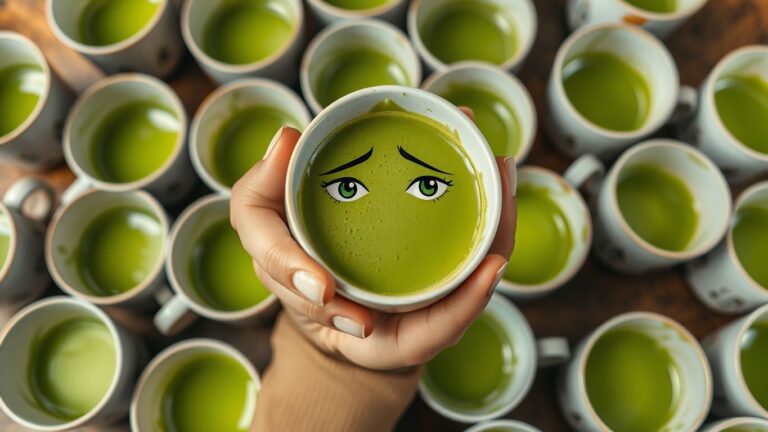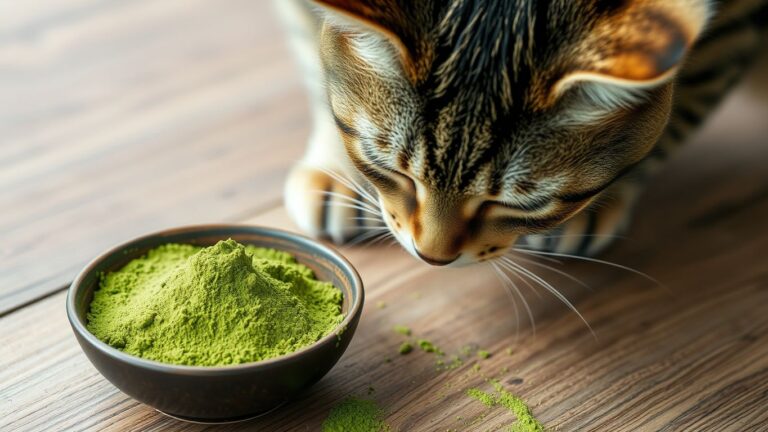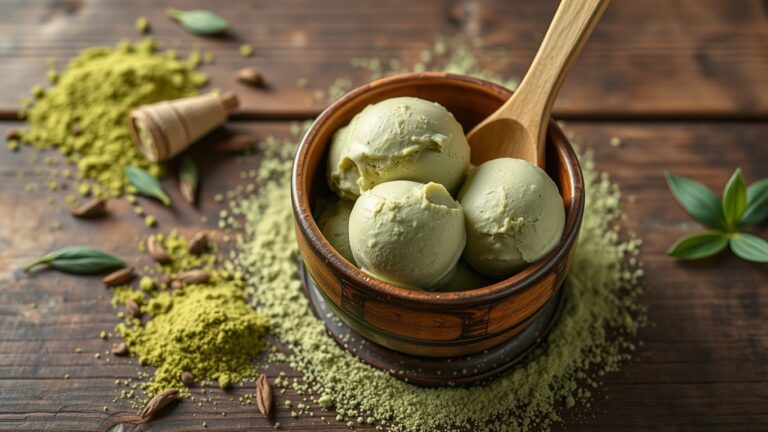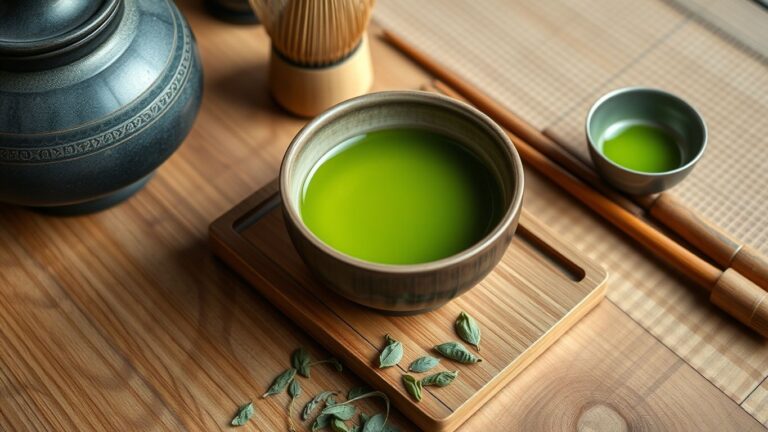Matcha is a special kind of powdered green tea that has a unique taste, often described as earthy, umami, and sometimes even fishy. This article will explore why matcha has such a distinct flavor by looking at its origins, the role of umami, the impact of chlorophyll, and the influence of growing conditions. We’ll also debunk common myths and provide tips for enjoying matcha to its fullest.
Key Takeaways
- Matcha’s unique flavor comes from its cultivation and processing methods, including shade-growing and stone-grinding.
- The umami taste in matcha is due to the presence of amino acids, which are also found in seaweed, giving it a slightly oceanic flavor.
- Chlorophyll, which gives matcha its vibrant green color, also contributes to its earthy and sometimes bitter taste.
- High-quality matcha has a balance of sweetness, bitterness, and umami, while lower-quality matcha can taste more bitter and less complex.
- Proper preparation and pairing with other ingredients can enhance matcha’s flavor and reduce any off-putting tastes.
The Origins of Matcha’s Unique Flavor
Historical Background of Matcha
The history of matcha green tea can be traced back to China, where it was first cultivated. The Chinese were the first to discover the unique method of grinding tea leaves into a fine powder. This technique was later adopted by Japanese monks, who found that matcha helped them stay alert during long meditation sessions.
Traditional Cultivation Methods
Matcha is made from shade-grown tea leaves, a practice that began in Japan. By shading the tea plants for about three weeks before harvest, the leaves produce more chlorophyll and amino acids, resulting in a richer flavor. After harvesting, the leaves are steamed, dried, and ground into a fine powder using traditional granite stone mills.
Cultural Significance in Japan
In Japan, matcha is more than just a drink; it’s a cultural experience. The Japanese tea ceremony, known as "chanoyu," is a ritualistic preparation and consumption of matcha. This ceremony emphasizes mindfulness, respect, and the appreciation of the tea’s flavor and aroma. Matcha’s unique flavor is deeply intertwined with Japanese culture and tradition.
The Umami Factor in Matcha
What is Umami?
Umami is a Japanese word that means "pleasant savory taste." It’s that deep, satisfying flavor that makes you want more. Think of the taste of soy sauce or Parmesan cheese. Umami is like a warm hug for your taste buds.
Amino Acids in Matcha
In matcha, this umami magic comes from amino acids, especially L-theanine and glutamic acid. These little flavor ninjas are naturally found in green tea leaves, particularly those grown in the shade like matcha. The shading process boosts these amino acids, resulting in that rich, savory goodness.
Comparison with Seaweed
Here’s the kicker – seaweed is also packed with glutamic acid, which is why matcha and seaweed share that umami flavor. When you sip on matcha and think, "Whoa, this tastes like the ocean," it’s those amino acids doing their thing. It’s like your taste buds are getting a savory hug from nature.
Chlorophyll and Its Impact on Taste
Role of Chlorophyll in Plants
Chlorophyll is the green pigment that allows plants to absorb sunlight and convert it into energy through photosynthesis. This pigment is essential for the plant’s growth and health, giving leaves their vibrant green color.
Chlorophyll in Matcha
Matcha tea plants are shaded for about three weeks before harvest, which increases their chlorophyll production. This shading process enriches the leaves with nutrients and gives matcha its beautiful green color.
How Chlorophyll Affects Flavor
Chlorophyll isn’t just for show; it has a significant impact on flavor. It gives matcha a fresh, grassy, and slightly sweet taste. This green goodness is what makes matcha taste, well, green. Seaweed also has high chlorophyll content, which explains why both share that earthy, oceanic flavor. When you drink matcha, you’re tasting the concentrated essence of green plants, similar to enjoying seaweed.
The shading process before harvest is like giving the tea plants a spa day for three weeks straight, making the leaves rich in nutrients and that beautiful green color.
The Influence of Growing Conditions
Shade-Grown Tea Leaves
Matcha tea plants are shaded for about three weeks before harvest. This shading process increases the chlorophyll content, giving matcha its vibrant green color and unique taste. The lack of direct sunlight also boosts the amino acids, making the flavor richer and smoother.
Soil and Climate Factors
The soil and climate where matcha is grown play a huge role in its flavor. Volcanic soil in regions like Uji and Kagoshima is rich in minerals, which makes the tea plants nutrient-dense. The climate, including factors like sunlight, rain, and ocean mist, also affects the aroma and flavor of the tea.
Regional Differences in Flavor
Different regions in Japan produce matcha with distinct flavor profiles. For example, matcha from Uji is known for its balanced taste, while matcha from Nishio might have a more robust flavor. These regional differences are due to variations in soil composition, altitude, and climate.
The Role of Antioxidants and Catechins

Matcha is not just a tasty drink; it’s packed with powerful antioxidants and catechins that offer numerous health benefits. These compounds are the secret behind matcha’s unique taste and its health-boosting properties.
Matcha Grades and Their Flavor Profiles
Ceremonial Grade Matcha
Ceremonial grade matcha is the highest quality matcha available. It’s made from the youngest tea leaves, which are shade-grown for about three weeks before harvest. This grade is known for its vibrant green color and smooth, delicate flavor. When you taste ceremonial grade matcha, you’ll notice fresh, crisp notes that evolve into a sweet, delicately grassy middle, and close with a lingering umami finish. This type of matcha is best enjoyed on its own, whisked with hot water.
Culinary Grade Matcha
Culinary grade matcha is more versatile and is often used in cooking and baking. It has a stronger, more robust flavor compared to ceremonial grade. This grade is perfect for adding to lattes, smoothies, and desserts. While it may not have the same delicate flavor profile as ceremonial grade, it still offers a pleasant taste that can complement a variety of dishes.
How to Choose the Right Grade
When choosing between ceremonial and culinary grade matcha, consider how you plan to use it. If you want to enjoy matcha in its purest form, go for ceremonial grade. If you’re looking to experiment with matcha in recipes, culinary grade is a great choice. Remember, the quality of matcha can greatly affect its flavor, so it’s worth investing in a good quality product.
Common Misconceptions About Matcha’s Taste

Does Matcha Taste Like Fish?
A common misconception is that matcha tastes like fish. This belief often stems from the umami flavor present in matcha, which can be similar to the savory taste found in seaweed. However, high-quality matcha should not have a fishy taste. If it does, it might be due to poor quality or improper storage.
Understanding the ‘Fishy’ Flavor
The ‘fishy’ flavor some people detect in matcha is usually a result of low-grade matcha. Low-quality matcha can have a stale aroma and a yellow-green or yellow-brown color. This type of matcha is often used for cooking, where other ingredients can mask its harsh taste.
How to Avoid Off-Flavors
To avoid off-flavors in your matcha, follow these tips:
- Choose high-quality matcha: Look for vibrant green matcha with a pleasant aroma.
- Store it properly: Keep matcha in an airtight container, away from light and moisture.
- Use the right water temperature: Hot water can make matcha taste bitter. Use water that is around 175°F (80°C).
- Whisk it well: Proper whisking can help achieve a smooth, clump-free texture.
Remember, matcha is an acquired taste. With the right preparation and quality, you can enjoy its unique and complex flavors.
Pairing Matcha with Other Ingredients

Matcha in Desserts and Sweets
Matcha’s unique flavor makes it a fantastic addition to desserts and sweets. You can find it in traditional Japanese sweets like wagashi, as well as in modern treats like matcha-flavored ice cream, cakes, and cookies. The earthy, slightly bitter taste of matcha pairs well with the sweetness of these desserts, creating a balanced and delightful flavor profile.
Matcha Lattes and Smoothies
One of the most popular ways to enjoy matcha is in lattes and smoothies. A ginger-orange matcha green tea smoothie can be a refreshing and healthy option. The combination of matcha with fruits like bananas, oranges, and a hint of ginger creates a vibrant and energizing drink. Matcha lattes, whether made with dairy or plant-based milk, offer a creamy and comforting way to enjoy this green tea powder.
Savory Dishes with Matcha
Matcha isn’t just for sweets and drinks; it can also be used in savory dishes. Incorporate matcha into sauces, dressings, and marinades to add a unique depth of flavor. It pairs well with umami-rich ingredients like miso and soy sauce, making it a versatile addition to your culinary repertoire.
Experimenting with matcha in both sweet and savory dishes can open up a world of new flavors and culinary possibilities. Don’t be afraid to get creative and try new combinations!
Tips for Preparing the Perfect Cup of Matcha
Choosing Quality Matcha Powder
To make a delicious cup of matcha, start with high-quality matcha powder. Look for a vibrant green color and a fine texture. Avoid matcha that appears dull or yellowish-green, as this can indicate poor quality. It’s also a good idea to buy matcha from reputable sources with positive reviews.
Proper Whisking Techniques
- Sift: Begin by sifting 1-2 teaspoons of matcha powder into a bowl. This helps remove any clumps and ensures a smooth texture.
- Add Water: Pour hot water at 80°C (176°F) into the bowl, about 1/3 of the bowl’s volume.
- Whisk: Using a bamboo whisk (chasen), whisk the matcha and water in a "W" or "M" motion until a frothy layer forms on top.
Serving Suggestions and Pairings
Matcha can be enjoyed in various ways. Here are some ideas:
- Traditional: Serve matcha as a simple tea, whisked with hot water.
- Matcha Latte: Combine matcha with steamed milk and a sweetener of your choice.
- Smoothies: Add matcha to your favorite smoothie recipe for a green tea twist.
- Desserts: Incorporate matcha into baked goods like cookies or cakes for a unique flavor.
Preparing matcha is an art that combines quality ingredients and proper techniques. With practice, you’ll be able to create a cup of matcha that is both delicious and visually appealing.
Remember, the key to a perfect cup of matcha is in the details. From choosing the right powder to mastering the whisking technique, each step plays a crucial role in the final taste. Enjoy your matcha journey!
Exploring the Complex Tasting Notes of Matcha

Vegetal and Grassy Notes
One of the most prominent tasting notes in high-quality matcha is its grassy, vegetal flavor. This comes from the green tea leaves that are harvested, steamed, and stone-ground into a fine powder. The steaming process, common to Japanese green teas, results in stronger vegetal notes compared to Chinese green teas, which are pan-fired and tend to be nuttier and milder.
Sweetness and Bitterness
Matcha has a unique balance of sweetness and bitterness. Initially, you might taste a slight bitterness, but this is often followed by a smooth umami flavor that transitions into a sweet aftertaste. This lingering sweetness helps balance out the stronger flavors and bitterness, making matcha a bittersweet experience.
The Lingering Aftertaste
Depending on the blend and preparation, matcha can leave a variety of aftertastes. You might notice a sweet nuttiness, an intense savory flavor, or even floral or bittersweet notes. This aftertaste lingers for a while and then slowly fades away, which is one of the reasons people become so obsessed with matcha. The complex aftertaste is a result of the shaded growth phase before harvest and the blending techniques used by tea masters.
The taste of matcha is a harmonious blend of umami, sweetness, vegetal notes, creaminess, and a touch of bitterness. This centuries-old tea tradition offers a unique and complex flavor profile that keeps people coming back for more.
Why Matcha is an Acquired Taste
Initial Reactions to Matcha
When you first try matcha, you might find its taste a bit surprising. The bitter flavor and savory finish can be quite strong. This is because matcha is packed with nutrients like caffeine and L-Theanine, which provide energy and promote relaxation.
Developing a Taste for Matcha
As you continue to drink matcha, you’ll start to appreciate its unique flavors. The umami, vegetal, and slightly sweet notes become more enjoyable over time. It’s like getting used to the taste of coffee or dark chocolate.
Appreciating the Complexity
Matcha’s complex flavor profile is what makes it so special. The aftertaste can be sweet, nutty, or even floral, and it lingers for a while. This complexity is why some people become obsessed with matcha, even though it might take some time to get used to it.
Have you ever heard about matcha? It’s a drink that might take some getting used to, but once you do, you’ll find it offers a lot of healthy ingredients and a unique taste experience.
Conclusion
In conclusion, the unique taste of matcha, often described as having hints of seaweed or fish, is a result of its complex blend of flavors. This includes the umami from amino acids, the vegetal notes from the shade-grown leaves, and the slight bitterness from its high antioxidant content. Understanding these elements helps us appreciate why matcha stands out among other teas. Whether you enjoy it in a traditional tea ceremony or as a modern latte, matcha offers a rich, flavorful experience that is both unique and delightful. So next time you sip on this vibrant green tea, remember the journey from leaf to cup that creates its distinctive taste.
Frequently Asked Questions
What does matcha taste like?
Matcha has a unique taste that combines a bit of bitterness with a touch of sweetness. It also has earthy and vegetal notes, making it quite different from regular green tea.
Why does matcha sometimes taste like fish?
If your matcha tastes like fish, it might be because of the amino acids in the tea leaves, which can give it a slight seaweed-like flavor. Poor storage conditions can also affect its taste.
Is matcha supposed to be bitter?
Yes, matcha can have a slight bitterness, especially if it’s of lower quality or not prepared correctly. However, good quality matcha has a balanced flavor with a hint of sweetness and umami.
How do I make matcha taste better?
You can improve the taste of matcha by using high-quality powder and preparing it correctly. Adding a bit of sweetener or mixing it with milk to make a latte can also enhance its flavor.
Does matcha have caffeine?
Yes, matcha contains caffeine. In fact, it has more caffeine than regular green tea because you consume the whole tea leaf in powdered form.
Can I drink matcha every day?
Yes, you can drink matcha daily. However, it’s best to consume it in moderation due to its caffeine content.
What’s the difference between ceremonial and culinary grade matcha?
Ceremonial grade matcha is made from the youngest tea leaves and is meant for drinking on its own. Culinary grade matcha is slightly more bitter and is best used in cooking and baking.
What are the health benefits of matcha?
Matcha is rich in antioxidants, boosts energy, helps with relaxation, and can improve cognitive function. It’s also good for your heart and metabolism.






